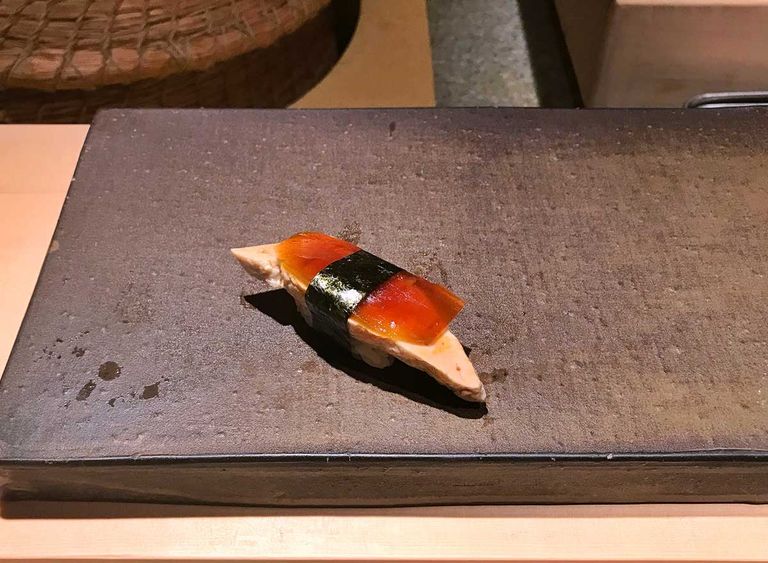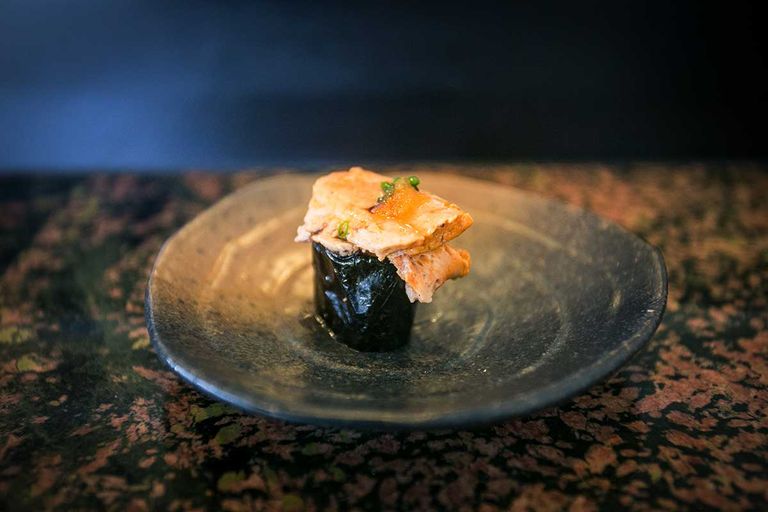Ankimo Sushi
A Comprehensive Overview of Liver of Goosefishes, Anglers or Monkfishes in Japanese Sushi Cuisine
あんきもすし 、 鮟肝寿司 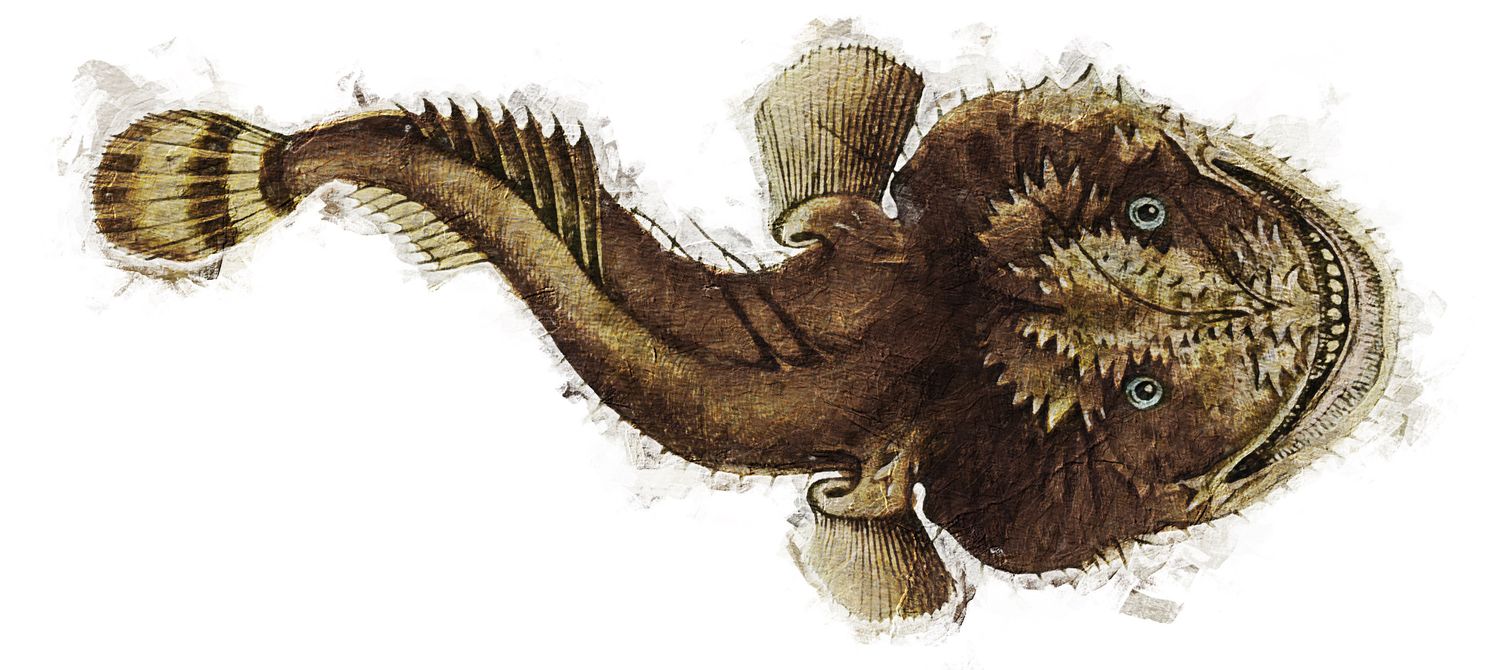
What is Ankimo?
Ankimo 鮟肝 is a Japanese dish made from the liver of an anglerfish. In Japan, ankimo is also known as umi no foagura 海のフォアグラ, which means “foie gras of the sea”. Preparing the liver of an anglerfish requires skill as well as an understanding of traditional Japanese cooking to preserve the liver's delicate texture and rich flavor. In Japan, ankimo is an essential part of washoku, which is deeply rooted in kaiseki cuisine and is a fundamental element in the art of sushi preparation.
Ankō 鮟鱇 (Lophiomus setigerus), and kiankō 黄鮟鱇 (Lophius litulon) which is native to Japan, is most commonly used for preparation. However, more and more imported European or American related species are also finding their way onto Japanese plates.
Ankimo for Sushi or Sashimi
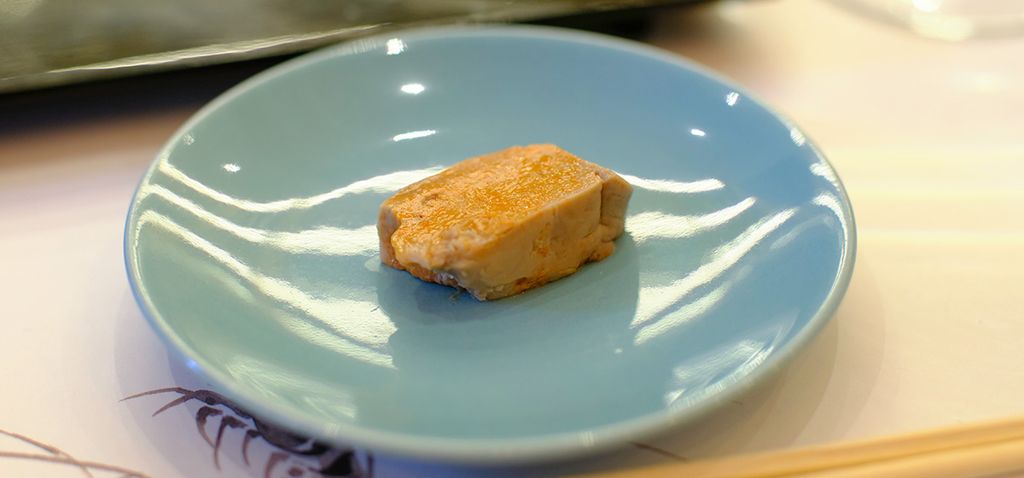
SushiPedia. Ankimo - Monkfish Liver Sushi. All rights reserved ©
Ankō are large and unappealing but extremely tasty, especially their liver. The taste of ankimo is very rich, less like fish, creamy but at the same time very light and tender. The soft texture gives a velvety feeling on the tongue, and the high fat content makes ankimo melt in the mouth. Ankimo is often served with grated radish with chili (momiji oroshi もみじおろし), finely chopped Japanese bunching onion (negi ネギ) and/or a citrus-based seasoning sauce (ponzu ポン酢). Contrary to the common practice with many Japanese sushi dishes, pairing ankimo with soy sauce is discouraged due to its propensity to overpower the subtle flavors of the ankimo. It is recommended to serve it cool, yet marginally warmer than refrigerator temperature.
After the fish has been filleted, the liver is first rubbed with salt and rinsed with alcohol (sake 酒). Carefully, the liver is freed from its large blood vessels, possibly parasites and membrane skin. It is then cooked in a cylinder made of aluminum foil. Ankimo is rich in vitamins, protein, and minerals. However, mercury compounds ingested in the fish's diet also accumulate in the liver, so it is best to refrain from eating large quantities of ankimo.
Ankimo is not exclusive to Japanese cuisine. In France, ankimo is known as foie de lotte. In Spain, the anglerfish liver is called hígado de rape and is highly appreciated.
Best Season for Ankimo
Traditionally, ankimo is a winter recipe in Japan, outside Japan it is often to be found in high-class sushi restaurants all year round. The unprocessed liver, or sometimes the prepared ankimo, is stored frozen to ensure a year-round supply.
Ankō in Japan
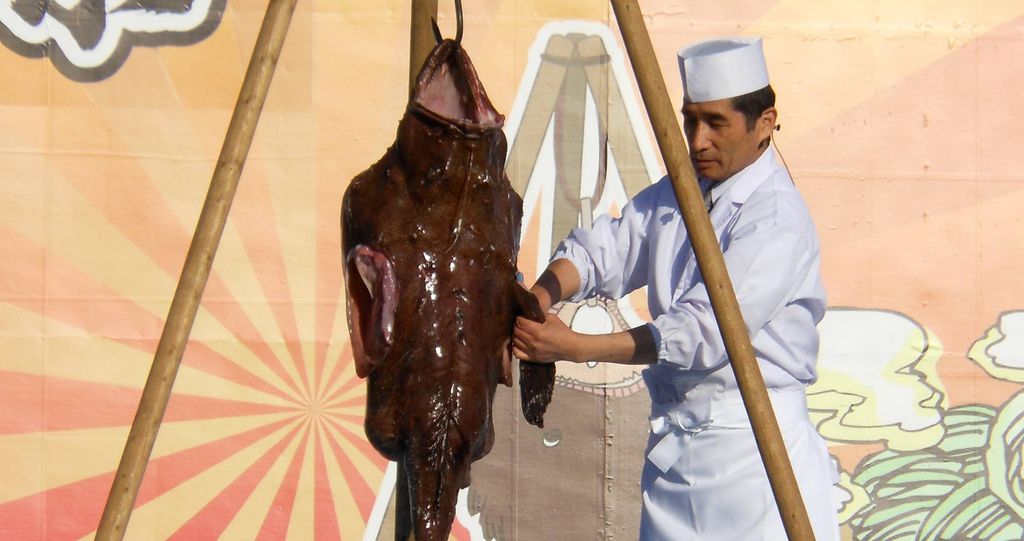
Miyuki Meinaka. Oarai Anglerfish Festival 2014, Cutting Anglerfish. wikimedia.org. Some rights reserved: CC BY-SA 4.0 DEED. Changes applied: brightness, contrast, noise, white balance
Anglerfish is traditionally eaten in winter. Although its appearance is not very appealing, anglerfish is popular in Japan for its flavorful character. In various regions of Japan, including Shimane, the city of Shimonoseki in Yamaguchi, the Shimokita Peninsula in Aomori and Oarai in Ibaraki, catching and preparing anglerfish is a cherished tradition. Several festivities take place during the cold season, including the Ankou Festival, which showcases the special features of the tsurushi-giri-method 吊るし切り. This technique, in which the voluminous and soft anglerfish is cut up while hanging on a hook, is evidence of the adaptation to the specific challenges of processing this fish. In the village of Kazamaura on the Shimokita Peninsula, setchu-giri 雪中切り, a traditional method of cutting the fish on snow, is part of the cultural heritage. Due to its special consistency, which is soft and characterized by a slimy skin surface, large anglerfish in particular is not suitable for traditional cutting techniques on a board. Instead, hanging for cutting has established itself as a practical method, as the anglerfish is difficult to work with due to its size of up to two meters and its difficult-to-handle nature. By hanging the fish, it is stretched by its own weight, which makes the body firmer and therefore easier to cut. Depending on the size, water is added to the fish's mouth to enhance the effect and further inflate the body, which creates the necessary tension for a precise cut.
Ibaraki Prefecture is considered one of the best places to enjoy anglerfish, especially during the season. Here, ankou nabe, a stew with various parts of anglerfish, is a culinary highlight. Another regional dish is ankou no dobu jiru, a rich soup that contains plenty of anglerfish parts. Aomori is prized for its yellow anglerfish (kiankou 黄鮟鱇), a local variety of anglerfish that is often prepared as ankou no tomoae — a mixture of anglerfish liver and meat marinated in miso 味噌 [1] [2].
Ankimo from the Anglerfish or Monkfish?
Monkfish represents a specific term within the broader category denoted by “anglerfish,” highlighting the linguistic distinction where monkfish serves as a hyponym of anglerfish. While “anglerfish” encompasses a wide range of species, including goosefish and frogfish, “monkfish” precisely refers to particular species within this genus Lophius. Monkfish specifically refers to any large, bottom-dwelling anglerfish within the genus Lophius, such as L. piscatorius, found in the Atlantic. This distinction underscores that while all monkfish are anglerfish, not all anglerfish are monkfish, thus negating the notion of these terms being synonyms [3]. To make a long story short: If ankimo is prepared from species of the genus Lophius, it could be translated as Monkfish liver, otherwise it would be Anglerflish liver.
Ecology of Ankimo
Anglerfish are bottom-dwelling fish that prefer to live in coastal waters of the continental shelf and the upper continental slopes. Their habitat extends from the intertidal zone to depths of over 1,000 meters. They are found in various oceans, including the Atlantic, Mediterranean, Arctic, Pacific and Indian Oceans.
These fish prefer sandy or muddy bottoms, where their excellent camouflage ability allows them to adapt to their surroundings. Their unique body shape and ability to change the color and texture of their body allows them to hide in the seabed and lie in wait for prey. Their diet consists mainly of fish and crustaceans, which surprise them with their sudden and rapid attack. Large species also prey on larger prey such as eels, gurnards, rays, and even diving seabirds.
The habitat of the anglerfish is characterized by its adaptation to colder and deeper waters, which makes them a widespread predator. Nevertheless, their habitats are endangered due to overfishing and environmental changes such as climate change and marine pollution.
The Angler of the Deep Sea: How It Catches Its Prey With a Unique Strategy
The anglerfish, also known as monkfish, owes its name to its unique hunting method, which is similar to angling. Its first dorsal fin ray has been transformed into a lure-like appendage, which is located directly above the fish's mouth and serves as a “fishing rod” to attract prey. This remarkable adaptation characterizes this deep-sea fish. In the darkness of the deep sea, the habitat of the anglerfish, food is often scarce and hard to find. Therefore, the anglerfish has developed an efficient strategy to attract prey instead of actively searching for it. The fishing appendage, which typically has luminescent properties, attracts smaller fish and other marine animals [4]. These bioluminescent properties are particularly effective in the lightless environment of the deep sea. As soon as a prey animal is attracted by the luminous bait and is within reach of the anglerfish, it snaps shut with its huge mouth at lightning speed. This catching technique is effective and energy-efficient, which is crucial in the food-scarce environment of the deep sea.
Economy of Ankimo
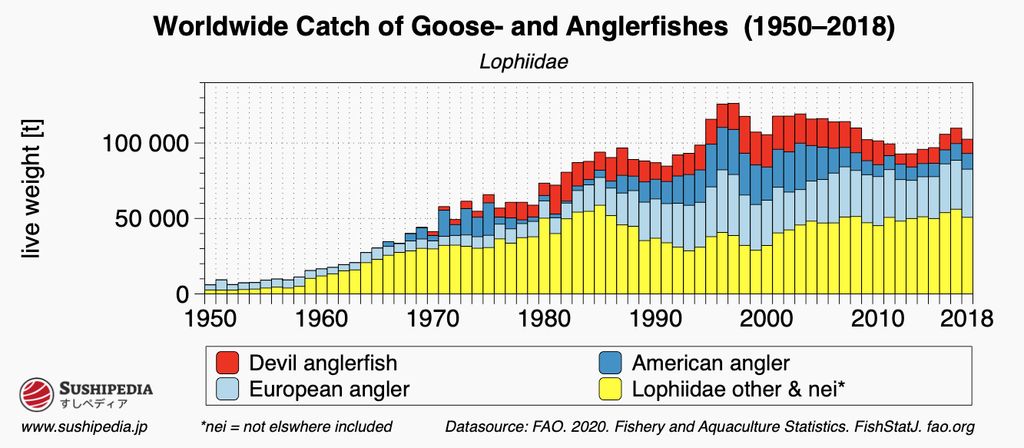
SushiPedia. Global Monkfish Catch Statistics. All rights reserved ©
The dominant method of catching anglerfish is bottom trawling. This type of fishing is extremely damaging to marine habitats on the seabed. In the North-East Atlantic, anglerfish stocks in Icelandic waters are in a healthy state and are not overfished. Similarly, positive conditions can be found in the Bay of Biscay and off the coast of Portugal. In contrast, stocks in the wider North Sea and west of Scotland are in decline, although fishing pressure continues to increase. Assessing fish stocks in the Mediterranean is challenging due to insufficient data. In contrast, anglerfish populations in the Southeast and Northwest Atlantic regions are harvested sustainably. Conversely, in the Northwest Pacific, excessive fishing pressure has resulted in a decline in anglerfish stocks, as reported by the World Wildlife Fund (WWF) in 2023 [5].
Video about Ankimo Sushi
External video embedded from: youTube.com. Credit How To Sushi. How to Prep Monkfish Liver (Ankimo)【Sushi Chef Eye View】.
Species for Ankimo
The following species are regarded as authentic ankimo. Either historically, according to the area of distribution or according to the common practice in today's gastronomy:
Sources and Further Reading
- [1]Savour the delicate flavours of ankou, or monkfish. Japan National Tourism Organization, 2022-02-25. Source retrieved 12/26/2023
- [2]Aomori Specialty Guide | Fish | Monkfish. Aomori Prefectural Government, 2019. Source retrieved 12/26/2023
- [3]The Fish Labelling (England) Regulations 2010. Legislation.gov.uk, The National Archives on behalf of HM Government, 2010. Source retrieved 3/11/2024
- [4]Marc Zimmer. Bioluminescence. Nature and Science at Work. Lerner Publishing Group. 2015
- [5]WWF Fischratgeber - Seeteufel . WWF Deutschland. Source retrieved 12/26/2023
- Joseph Favre. Practical universal kitchen dictionary (Dictionnaire universel de cuisine pratique). Place des éditeurs. 2010
- Kadowaki Toshiya (門脇俊哉), Aihara Takateru (粟飯原崇光), Hashimoto Mikizō (橋本幹造), Kobayashi Yūji (小林雄二), Ōhara Makoto (大原誠). Seasonal appetizers and entrées (季節を彩るお通しと前菜). Natsumesha, Tokyo (ナツメ社, 東京都). 2015
- Nick Sakagami. Sushi Master: An expert guide to sourcing, making and enjoying sushi at home. Quarry Books, Beverly. 2019
- Ole Mouritsen, Klavs Styrbæk, Mariela Johansen. Umami: Unlocking the Secrets of the Fifth Taste. Columbia University Press, New York. 2014
- Taras Grescoe. Dead Seas: How the fish on our plates is killing our planet. Pan Macmillan, Basingstoke. 2012
- IUCN Red List of Threatened Species. Version 2023-1
Image Credits
- Miyuki Meinaka. Oarai Anglerfish Festival 2014, Cutting Anglerfish. wikimedia.org. Some rights reserved: CC BY-SA 4.0 DEED. Changes applied: brightness, contrast, noise, white balance
- SushiPedia. Global Monkfish Catch Statistics. All rights reserved ©
- City Foodsters (Grace Chen, Jason Wang). Ankimo (Monkfish Liver). flickr.com. Some rights reserved: CC BY 2.0. Changes applied: brightness, contrast, noise, white balance
- SushiPedia. Ankimo - Monkfish Liver Sushi. All rights reserved ©
- SushiPedia. Ankimo Sushi. All rights reserved ©
- T.Tseng. Ankimo, preserved watermelon. flickr.com. Some rights reserved: CC BY 2.0. Changes applied: brightness, contrast, noise, white balance
